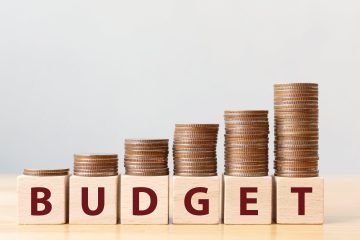Table of Contents
- Understanding Your Food Budget and Why It Matters
- Setting Realistic Monthly Goals for Grocery Spending
- Smart Shopping Strategies to Maximize Your Budget
- Meal Planning Techniques for Cost Efficiency
- Flexible Approaches to Adjusting Your Food Budget
- Q&A
- Final Thoughts


Understanding Your Food Budget and Why It Matters
Managing your financial resources begins with a clear understanding of your food budget. It’s not just about tracking how much you spend; it’s about being intentional with your purchasing decisions to enable nutritious eating while minimizing waste. Establishing a budget allows you to prioritize foods that are both healthy and economical, promoting a balanced diet without breaking the bank.
Here are some essential factors to consider when determining your food budget:
- Income: Assess your overall financial situation to allocate an appropriate amount for food expenses.
- Household Size: Consider the number of people you’re feeding, as this will significantly impact your costs.
- Dietary Needs: Special dietary requirements or preferences may affect your options and prices.
- Shopping Habits: Evaluate whether you buy in bulk, shop sales, or prefer convenience stores, as these habits impact your spending.
To help visualize your spending, consider creating a simple budget table that breaks down categories of food expenses:
| Category | Monthly Budget | Actual Spending |
|---|---|---|
| Groceries | $300 | $280 |
| Eating Out | $100 | $120 |
| Snacks & Treats | $50 | $40 |
By consistently reviewing these figures, you can make informed adjustments. Understanding your food budget not only empowers you to make smarter choices but also fosters greater awareness of your overall financial health and well-being.


Setting Realistic Monthly Goals for Grocery Spending
Establishing a sensible monthly grocery budget is essential for managing your finances effectively. Start by analyzing your current spending habits. This involves reviewing previous receipts and bank statements to determine where your money goes. Assess your family size, dietary preferences, and typical shopping frequency to get a clearer picture. Setting a baseline for your grocery expenses will guide you in making informed adjustments.
Next, it’s important to set specific, achievable goals based on your findings. Consider dividing your grocery spending into categories such as essentials, snacks, and special treats. This will not only help you track your spending but also ensure you don’t overspend in areas that typically don’t require as much budget allocation. Aim to allocate around 50-60% of your total grocery budget to essentials, which might include proteins, grains, and fresh produce.
don’t forget to account for occasional fluctuations in grocery prices, especially for seasonal items. Creating a flexible budget can help accommodate these variations without causing undue stress. You may want to implement a savings tracker, which can be as simple as a table comparing your budgeted vs. actual spending. Here is an example of what that might look like:
| Category | Budgeted Amount | Actual Amount | Difference |
|---|---|---|---|
| Essentials | $300 | $250 | $50 |
| Snacks | $100 | $120 | -$20 |
| Treats | $50 | $40 | $10 |
By continually reassessing your spending through this method, you can fine-tune your monthly grocery goals. You’ll not only save money but also cultivate healthier shopping habits in the process.


Smart Shopping Strategies to Maximize Your Budget
Planning your grocery trips with a clear outline can significantly enhance your ability to stick to your budget. Start by creating a weekly meal plan that utilizes ingredients you already have at home, combined with fresh items that need to be purchased. This approach not only reduces waste but also guides your shopping list, making it easier to resist the temptation of impulse buys. Don’t forget to check for any sales or discounts available for items on your list, as this can allow you to stretch your dollars even further.
When shopping, consider utilizing price comparison apps that allow you to scan local store prices quickly. Many retailers offer their own loyalty programs that can lead to additional savings. Also, consider buying in bulk for non-perishable items or products used frequently, as this often results in a lower cost per unit. Here are some categories where bulk buying can be beneficial:
- Canned goods
- Grains like rice or quinoa
- Pasta and sauces
- Frozen vegetables and fruits
Another effective strategy is to utilize cashback and couponing sites to find additional savings. By consistently searching for digital or physical coupons before purchasing, you can significantly reduce your total grocery bill. For instance, consider the following simple table to keep track of coupons and cashback opportunities:
| Store | Coupon Available | Cashback Offer |
|---|---|---|
| Store A | 10% off on next purchase | $5 cashback on orders over $50 |
| Store B | Bogo on selected items | 3% cashback on entire order |
| Store C | $2 off any produce | No cashback |


Meal Planning Techniques for Cost Efficiency
Effective meal planning is a powerful tool for maximizing your food budget. By strategically organizing your meals for the week, you can significantly lower food waste and ensure you’re only buying what you need. Here are several techniques to help streamline your meal preparation:
- Create a weekly menu: Plan out your meals for the week, including breakfasts, lunches, and dinners. This gives you a clear guide for shopping and reduces impulse purchases.
- Batch cooking: Prepare large quantities of meals that can be portioned out and stored for later. Dishes like soups, stews, and casseroles freeze well and can save time and energy on busy weekdays.
- Utilize seasonal produce: Focus on buying fruits and vegetables that are in season. They are often cheaper, fresher, and more flavorful, enhancing the overall quality of your meals.
Shopping smartly is just as crucial as planning your meals. Take advantage of store sales, coupons, and bulk buying opportunities. Here’s a simple approach to help maximize savings:
| Store Section | Best Strategies |
|---|---|
| Produce | Buy in-season and local |
| Meat | Buy in bulk and freeze |
| Grains | Look for deals on bulk items |
Don’t overlook the importance of utilizing ingredients across multiple meals. This not only minimizes waste but also keeps meal preparation efficient. Select versatile ingredients that can be used in various dishes:
- Rice: A base for stir-fries, bowls, or as a side dish.
- Beans: Great for salads, soups, or chili.
- Chicken: Can be roasted, shredded for tacos, or added to salads.


Flexible Approaches to Adjusting Your Food Budget
Adjusting your food budget doesn’t have to feel like a daunting task. By embracing flexible strategies, you can ensure that your spending on groceries aligns with your financial goals without sacrificing the quality or enjoyment of your meals. One effective method is to prioritize your ingredients based on seasonal availability and local offerings. Not only does this approach often result in fresher, tastier produce, but it also tends to be friendlier on your wallet. Look for ways to incorporate what’s in season into your weekly menu.
Another key tactic is to leverage meal planning and bulk buying. Planning your meals for the week can help reduce impulse buys and minimize food waste. Consider these steps when planning:
- Assess Your Pantry: Take inventory of what you already have.
- Create a Meal Plan: Base it around your pantry staples and fresh items.
- Buy in Bulk: Purchase non-perishable items like grains and legumes in larger quantities for better deals.
don’t overlook the importance of adjusting your budget dynamically based on your needs. Some weeks you may want to splurge on gourmet ingredients or specialty items, while other weeks might call for stricter budgeting. Implementing a simple tracking system can help you stay on track. Below is a sample budget tracker:
| Week | Planned Budget | Actual Spend | Notes |
|---|---|---|---|
| Week 1 | $100 | $95 | Stuck to the meal plan |
| Week 2 | $100 | $120 | Splurged on organic produce |
| Week 3 | $100 | $85 | Used pantry items |
Q&A
Q&A: Food Budget Guidelines
Q1: What are food budget guidelines and why are they important?A1: Food budget guidelines are structured recommendations designed to help individuals and families manage their grocery expenses effectively. They play a vital role in fostering financial literacy and ensuring that people make informed decisions about their food purchases, thus promoting healthier eating habits while staying within a manageable budget.Q2: How do I determine my monthly food budget?A2: To determine your monthly food budget, start by evaluating your income and essential expenses. A good rule of thumb is to allocate 10-15% of your total monthly income to food costs. Keep track of your current spending for a month to get a realistic estimate, then adjust based on your financial goals and dietary needs.
Q3: What are some tips for sticking to a food budget?A3: Sticking to a food budget can be easier with these strategies:
- Plan Your Meals: Create a weekly meal plan to minimize impulse purchases.
- Make a Shopping List: Stick to your list to avoid buying unnecessary items.
- Buy in Bulk: Purchase non-perishable items in larger quantities for savings.
- Use Coupons and Discounts: Look for sales and promotional offers to cut costs.
- Limit Eating Out: Cooking at home is generally more economical than dining out.
Q4: Are there specific food categories to prioritize in my budget?A4: Yes, focusing on whole foods can maximize your budget’s nutritional value. Prioritize:
- Fruits and Vegetables: Fresh, frozen, or canned (without added sugars or salts).
- Grains: Choose whole grains like brown rice, whole wheat bread, and oats.
- Proteins: Incorporate beans, lentils, eggs, and lean meats to provide essential nutrients.
- Dairy or Dairy Alternatives: Look for affordable options that fit your dietary preferences.
Q5: How can I adjust my budget for dietary restrictions?A5: If you have dietary restrictions, adjust your budget by focusing on versatile ingredients that fit your needs. Research and find alternative options that provide similar nutritional value. Consider meal prepping and cooking in bulk to reduce costs and waste, and explore local resources such as community gardens or farmer’s markets for fresh produce at lower prices.
Q6: What resources are available for those struggling with food costs?A6: There are numerous resources available for those facing difficulties with food costs, including:
- Local food banks and pantries that provide free groceries.
- Government assistance programs such as Supplemental Nutrition Assistance Program (SNAP).
- Community organizations offering cooking classes and budgeting workshops to promote healthy eating on a budget.
Q7: What are some budgeting tools or apps you recommend?A7: Several budgeting tools and apps can simplify managing your food budget, such as:
- You Need a Budget (YNAB): A comprehensive budgeting tool that helps track expenses.
- Mint: An app that monitors your budget and financial goals.
- Green Pantry: Specifically designed for food budgeting, helping you plan meals and track expenditures.
Q8: How frequently should I review and adjust my food budget?A8: It’s a good practice to review your food budget monthly. This allows you to assess any changes in income, spending habits, and dietary needs. Adjusting regularly ensures that your budget remains realistic, effective, and aligned with your financial goals and lifestyle changes.
Adhering to these food budget guidelines can empower you to take control of your spending while enjoying delicious and nutritious meals. Whether you’re aiming to save for a goal or simply want to be more conscious of your expenses, finding a balance is key to successful budgeting.




0 Comments